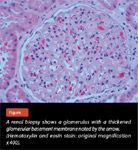Teenage boy with fever, flank pain
After developing fever and left-sided lower back pain, a previously healthy 15-year-old boy had been diagnosed by his private physician with a urinary tract infection and treated with trimethorpim-sulfamethoxazole for 7 days.

Key Points
The Case
After developing fever and left-sided lower back pain, a previously healthy 15-year-old boy had been diagnosed by his private physician with a urinary tract infection (UTI) and treated with trimethoprim-sulfamethoxazole for 7 days. His symptoms subsided after 3 days of treatment, only to reappear with a recorded fever of 103°F and left-sided lower back pain that twice woke him from sleep, which makes him come to your emergency department.
The boy's primary care doctor reported a moderate amount of blood and 2+ protein on urinalysis; the urine culture was negative, which is not surprising because UTI is quite rare in a 15-year-old boy (in contrast to a girl of the same age); however, the hematuria and proteinuria make you suspicious that something is going on in the urinary tract. The patient denies any vomiting, diarrhea, urinary complaints, weight loss, night sweats, change in appetite, joint pains, rash, or recent travel as well as any history of trauma. His past medical history is remarkable for seizure disorder as a young child, but he has had no antiepileptics or seizures since age 5. He denies nonsteroidal anti-inflammatory drug use. The family history is significant for nephrolithiasis in his father.

Laboratory data reveal an unremarkable complete blood count. The urinalysis shows urine protein above 300 mg/dL, negative leukocyte esterase and nitrite, moderate blood, 2 to 5 white blood cells/high power field (hpf), 10 to 20 red blood cells/hpf, and 20 to 50 hyaline casts/hpf.
Comprehensive metabolic panel is noted to be remarkable for creatinine of 1.3 mg/dL, total protein of 5.2 g/dL, and albumin of 2.3 g/dL. Results of the lipid panel show an elevated cholesterol and low-density lipoprotein cholesterol of 301 mg/dL and 213 mg/dL, respectively.
Differentials
Based on the clinical presentation, you think of the possible etiologies. Fever with flank pain makes you suspicious of pyelonephritis, but absence of pyuria makes it unlikely. Hematuria, unilateral flank pain, and family history point you toward an evaluation for a renal stone, whereas proteinuria, hypoalbuminemia, edema, and hyperlipidemia make you think of nephrotic syndrome.

Is it a renal stone?
A computed tomography (CT) scan of the abdomen without contrast shows bilaterally enlarged kidneys with no evidence of stones or obstruction, but the radiologist is concerned about a possible left renal vein thrombosis. You decide to admit this patient.

Further workup
Urine culture shows no growth, and 24-hour urine collection shows 9 g of protein. Fluorescent antinuclear antibody (ANA) returns positive with a speckled pattern, and the ANA titer is 1:640. The patient tests positive for anti-RNP and anti-Sm antibodies. Anti-DNA antibody, anti-SSA, and anti-SSB antibodies are negative. Antistreptolysin O titer is 119 IU/mL (normal, 0-200 IU/mL). Hepatitis B surface antigen, hepatitis B IgM core antibody, and hepatitis C virus antibody tests are negative. Complement studies show C3 and C4 fractions normal at 168 mg/dL and 61 mg/dL, respectively, and rheumatoid factor less than 20 IU/mL. The coagulation profile shows normal prothrombin time at 13.2 seconds and prolonged activated partial thromboplastin time at 33.7 seconds. Total and free protein C levels are normal at 146% of normal and 99% of normal, respectively. Total protein S antigen is elevated at 200% of normal. Free protein S level is low at 44% of normal.
Results are normal for antithrombin III levels and negative for factor V Leiden mutation studies and prothrombin G20210A gene mutation, as well as for cardiolipin antibodies IgG and IgM. You decide to anticoagulate the patient with heparin. On day 4, the heparin is discontinued for a kidney biopsy.